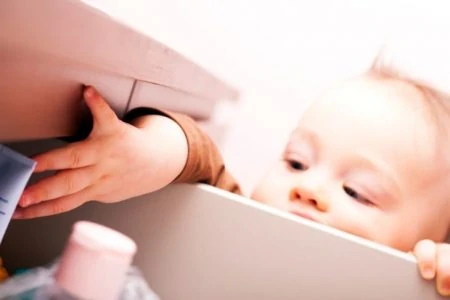Contact with electricity is dangerous for any baby. So, how do you babyproof electrical outlets and cords to ensure your children stay safe as they grow?
Babyproofing can be overwhelming, especially for first-time parents. Electrical outlets and cords are some of the most critical areas to babyproof, but it is often easy to miss something. After all, so many of our everyday essentials need to be frequently plugged in.
To help stressed mamas feel more confident, we have gathered everything you need to know about babyproofing all things electrical in your home.
In this guide, we will cover everything you need to know about babyproofing electrical outlets and cords — from what type of electrical plug covers are available to practical advice on teaching your children to use electronics properly.
Key Takeaways
- Babyproof electrical outlets with covers such as plastic outlet covers, outlet boxes, and self-closing outlet covers.
- Protect children from electrical cords by using cord shorteners, covers, straps, wraps, and protectors.
- Use power strip covers or individual outlet covers to babyproof power strips and minimize electrical hazards.
- Teach children about electrical safety and set rules for using appliances to prevent injuries and accidents.
How To Babyproof Electrical Outlets
It is essential to understand the very real dangers posed by electrical outlets.
The U.S. Consumer Product Safety Commission reported more than 24,000 children over a ten-year period were admitted to the emergency room due to incidents with electrical receptacles (1). This is approximately seven children every day, with 89% of them being under the age of six.
How do you effectively babyproof electrical outlets to avoid these scary statistics? First, you need to understand what sort of outlets you have in your home and then get the correct guards to make them inaccessible to little hands.
Types of Electrical Outlets
There are currently 15 types of electrical outlets around the world assigned by the U.S. Department of Commerce International Trade Administration (2). In the United States, we use “A” and “B” electrical outlets.
You may know these outlets better by the number of prongs they receive from a plug. The “A” outlet is two-pronged while the “B” outlet has three. It becomes tricky when you look at the many options available in these two subsets.
We will focus on the two most popular “B” outlet types, which are also the most common in homes today.
1. GFCI Outlets
Ground-fault circuit interrupter (GFCI) outlets dramatically reduce the risk of electric shock by registering the power flow between the appliance you plug in, such as a hairdryer, and anything that may interrupt it.
These interruptions primarily result from the appliance coming into contact with water or overheating.
You can tell if you have GFCI outlets by looking for “reset” and “test” buttons on the outlet. These buttons are designed to help you test the outlet’s ability to stop the current from flowing and providing power.
2. AFCI Outlets
Arc Fault Circuit Interrupter (AFCI) outlets are similar to GFCI outlets. They are designed to prevent danger to you and your family by preventing arcs in your electricity.
An arc fault occurs when damaged wires do not connect properly and cause sparking. This can be extremely dangerous because the sparks from an arc fault can easily catch insulation or framing on fire.
The Problem With Outlets
Both A and B plugs have a very short space between the conductors and the plastic outlet covering them. So, no matter what type of outlet you have in your home, you should consider all outlets dangerous.
Types Of Electrical Outlet Covers
The easiest way to protect your children from the dangers posed by electrical outlets is to use a guard. The type of guard you use will depend on your electrical outlet. Here’s what you should know about three of the most commonly used electrical outlet covers.
1. Plastic Outlet Covers

You have likely seen outlet covers before. They are generally made of durable plastic and have prongs that fit inside the outlet, preventing direct contact with objects or fingers. The covers are difficult for small fingers to remove.
Plastic electrical outlet covers fit any style of outlet you may have in your home. Multiple designs are available with varying levels of security to fit your specific needs.
- Pros: You can purchase plastic outlet covers in bulk, and they’re inexpensive. This is helpful if you need to babyproof your entire home. Adults can easily remove them when an outlet is needed.
- Cons: Children can learn to pull out the plastic outlet covers as they get older. If a child pulls out a cover halfway, the current will be live and can shock them. The covers can also become choking hazards.
2. Outlet Boxes
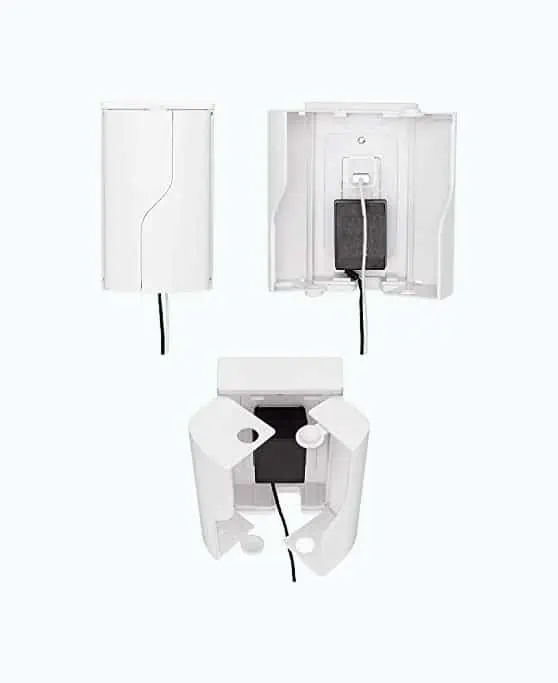
Many people use outlet boxes to protect outdoor electrical outlets. However, they can also be helpful for babyproofing.
An outlet box completely covers the outlet and even has room for appliance cords. Look for an outlet box with a two-button release system. This will make it extremely hard for your child to open.
- Pros: Outlet boxes are great for heavier appliances you plug in permanently, such as washers, dryers, televisions, and refrigerators. When an outlet and cord are exposed on these large appliances, parents often unplug them and use an outlet cover. However, this means you have to plug in the large appliance each time you want to use it. An outlet box saves you from worrying about this problem by permanently blocking access to the outlet.
- Cons: Because outlet boxes are often designed to keep out the weather rather than children, it might be tough to find a box for babyproofing. You do not want to buy one that can simply be lifted or popped off. Outlet boxes are also bigger, so if you are short on space, they may not fit.
3. Self-Closing Outlet Covers
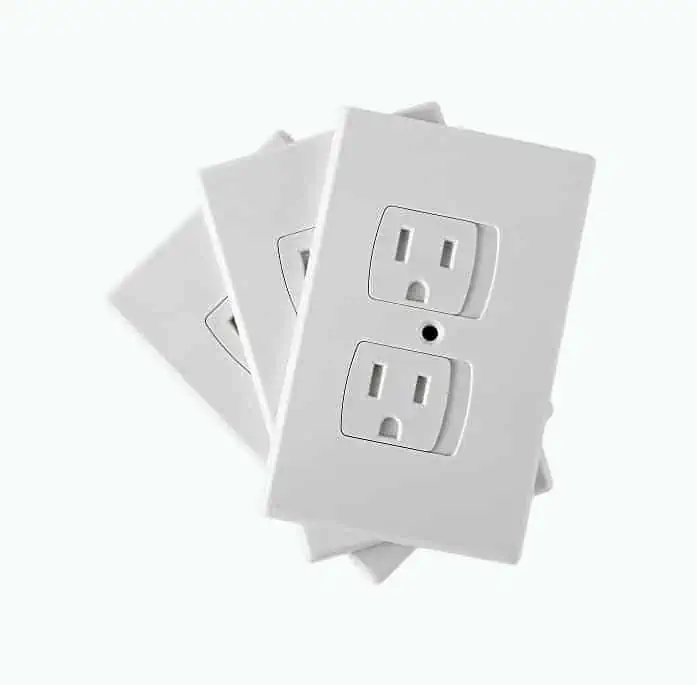
Self-closing outlet covers are also known as sliding covers. They were created to replace your entire existing outlet cover. To install, you remove the screws holding the existing cover over the outlet and replace it with a self-closing one.
When you remove a plug from the outlet, the cover will automatically slide over the holes, preventing anything from being inserted. Most self-closing outlets have a slide function; to plug something in, simply slide the cover over to expose the plug holes.
- Pros: Self-closing outlets are considered one of the most effective covers for protecting your children. There are no pieces to break off, and a child cannot remove them since they act as the entire outlet cover.
- Cons: It takes some elbow grease to go through your home and replace all the previously installed outlet covers. If you are short on time or are uncomfortable using screwdrivers, self-closing covers may be a more complicated option.
Remember
How To Babyproof Electrical Cords
Electrical outlet covers are great for outlets you do not use often. However, there is a good chance most of your outlets are consistently being used.
Just think of all of your chargers, lamps, video games, and entertainment systems. Then there are hairdryers, curling irons, toasters, blenders, vacuum cleaners, and more. Many of these also have long cords.
Long cords are dangerous because kids can:
- Pull out the cord and gain access to the outlet.
- Wrap the cord around their necks and choke.
- Chew on the cord and get shocked.
- Play with damaged, fraying cords.
- Suffer electrical burns.
- Trip over long cords.
What’s a modern family to do? Luckily, babyproofing your electrical cords is easier than you think. Follow these five simple steps:
1. Evaluate Exposed Outlets
The easiest way to keep cords away from little hands is to use furniture to block access to them. Go through your home and see which outlets are exposed. If possible, strategically place furniture in front of them as a barrier.
Pro Tip
2. Get a Cord Shortener or Cover
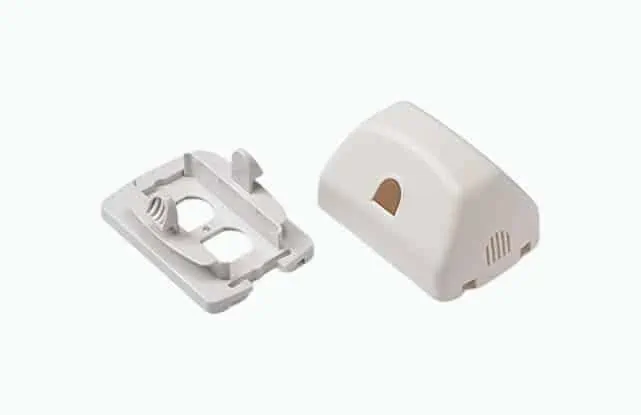
Get a cord shortener, cord cover, or both if you cannot place a barrier in front of electrical outlets.
A cord shortener allows you to store the excess of a long cord inside a receptacle your child can’t access. This prevents tugging and pulling on the cord.
A cord cover often comes combined with an outlet cover. It keeps the plug and part of the cord hidden away so it cannot be pulled out of the outlet.
3. Strap Cords Down
You may have long cords running along a wall or across a room in some cases. Use tape to adhere them to the floor, or cover them with carpets.
You can also use duct cord covers. Duct cord covers allow you to string multiple cords through a silicone or plastic cover that stays on the floor.
This prevents children from tripping on or pulling long cords and damaging items.
4. Wrap Cords
![Product Image of the [4 Pack] JOTO Cable Management Sleeve, 19-20 Inch Cord Organizer System with...](https://momlovesbest.com/wp-content/uploads/product-thumbnails/4-Pack-JOTO-Cable-Manag-pt.webp)
In areas of your home where you have multiple cords, such as near a computer or media center, wrap the cords together. It helps keep things organized, and children will be less likely to play with them.
There are multiple devices to help you wrap cords together. We suggest using a cord sleeve. Cord sleeves are much harder to remove and do not pose a potential choking hazard if removed.
5. Cord Protectors
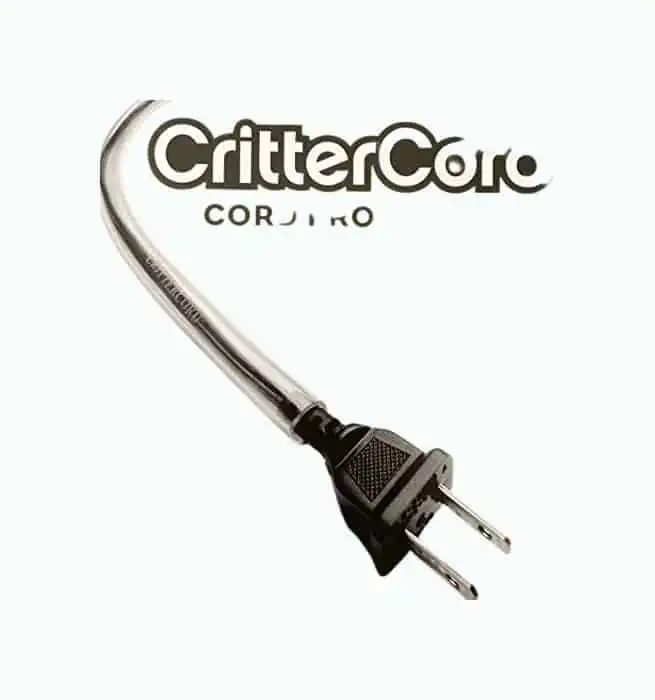
Cord protectors keep cords safe from your children. If your child tries to bend, bite, or otherwise spoil the cord, the cord protector will prevent damage to the cord. This also protects your baby from damaged cords.
Cord protectors are a good option if you have unruly children and want to avoid replacing damaged cords regularly.
How To Babyproof Power Strips

Power strips can expose kids to an excessive amount of electricity in one place. Prevent your power strip from becoming a dangerous toy by purchasing a power strip cover.
Power strip covers are generally made of plastic and have a long slit on one side. The slit allows the cords to come through while covering the outlets and power button.
In place of a power strip cover, you can also use plastic electric outlet covers for individual outlets on the power strip.
Teach Your Children To Use Electricity Safely
As your children get older, teaching them to use electricity safely is an effective way to prevent injuries and emergencies.
Here are five things you can do and five things your child can do to support electrical safety in the home.
Parents:
- Avoid plugging and unplugging cords when young children are watching.
- Avoid putting fun and colorful objects near electrical outlets.
- Set rules on who can turn on lamps and electronics.
- Avoid leaving appliances (such as hair dryers) plugged in when not in use.
- Provide children with supervised opportunities to use electric appliances.
Children:
- Watch videos about electrical safety.
- Learn warning signs, such as sparking objects or frayed cords.
- Obey rules set by parents.
- Ask parents for help when needing to plug things in.
- Keep electronics away from water.
Remember

